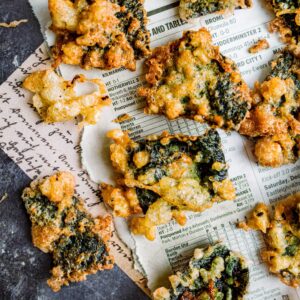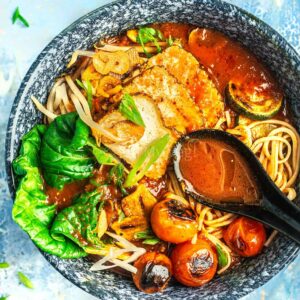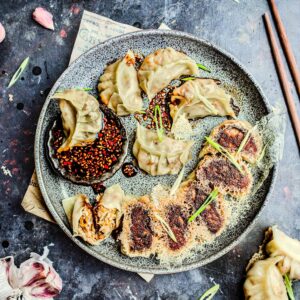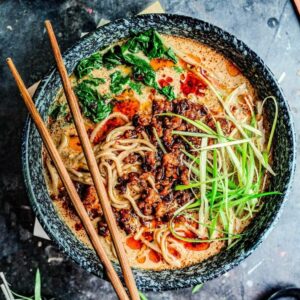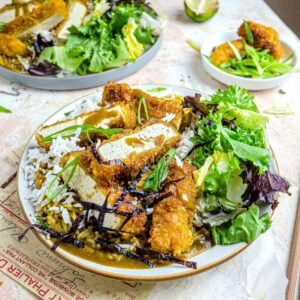Peanut Avocado Rolls, Uramaki
These peanut avocado rolls are the ultimate vegan sushi treat! Think soft, fluffy sushi rice wrapped around buttery avocado, sweet crunch from the peanuts, and umami-rich nori. It’s a perfect balance of creamy, crunchy, and savoury — and SO much cheaper than buying sushi.
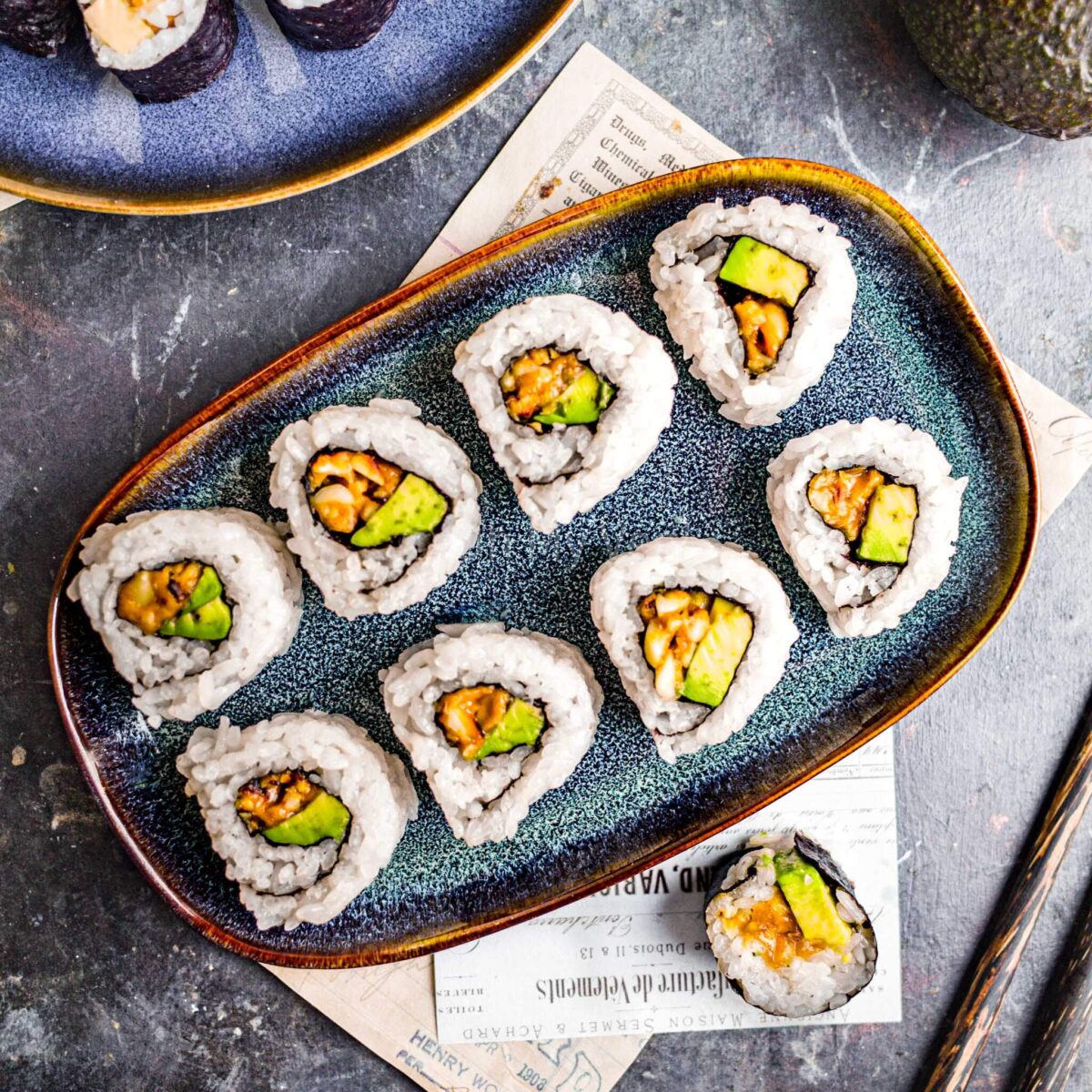
On first impression, peanuts in sushi may seem like an odd combination. But trust me, it works! Avocado maki are delicious — but the sweet, crunchy peanut filling massively elevates them. While avocado is soft and creamy, the peanuts offer a satisfying crunch, plus tons of plant-based protein.
Peanut is a fantastic pairing for Asian foods. Similar flavours are also present in my tofu satay curry, one of the most popular recipes on my site.
While it took me a few tries to perfect these rolls, but now they’re just as good (or better) than the ones you’d get for takeout. They’re sweet, creamy, and crunchy, with slightly tangy rice and umami-packed sushi nori. YUM.
Moreover, did I mention these peanut avocado rolls are completely vegan and gluten free?
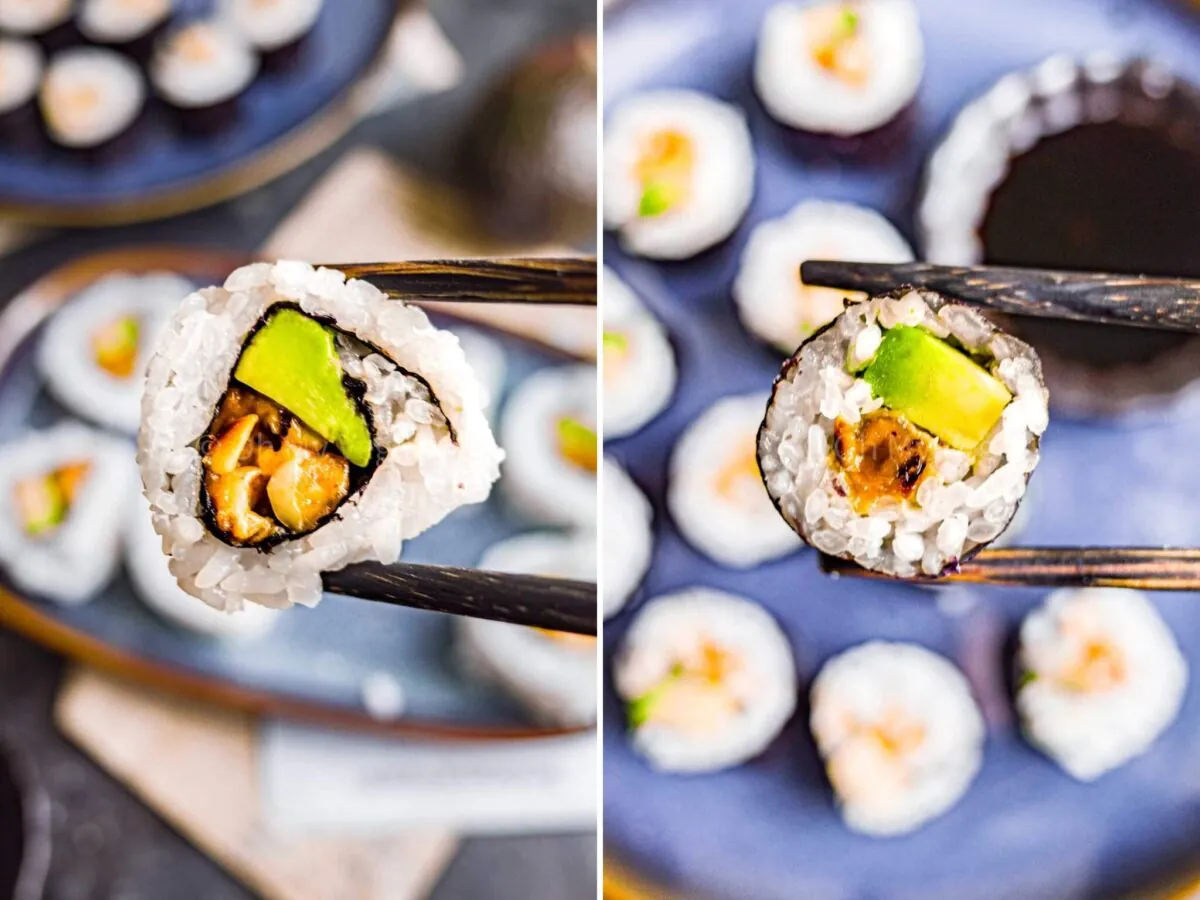
🌎 Where are Peanut Avocado Rolls From?
Interestingly, peanut avocado rolls don’t seem to have worldwide fame yet. I first discovered them when I was living in California — the state is flooded with delicious plant-based Japanese food, and I instantly fell in love with this unique take on vegan sushi rolls.
However, when I returned to the U.K., I hunted them out everywhere — no luck! Since then, I’ve heard peanut avocado rolls are hard to come by in other areas of the U.S., too. Maybe some of my lovely U.S.-based readers can tell me: Have you tried these before?
As far as I know, this isn’t a traditional Japanese recipe, meaning you likely won’t find it in Japan. Much like the ubiquitous California roll, most sources agree the unique vegan sushi rolls were invented in the 1980s by Japanese-American immigrants.
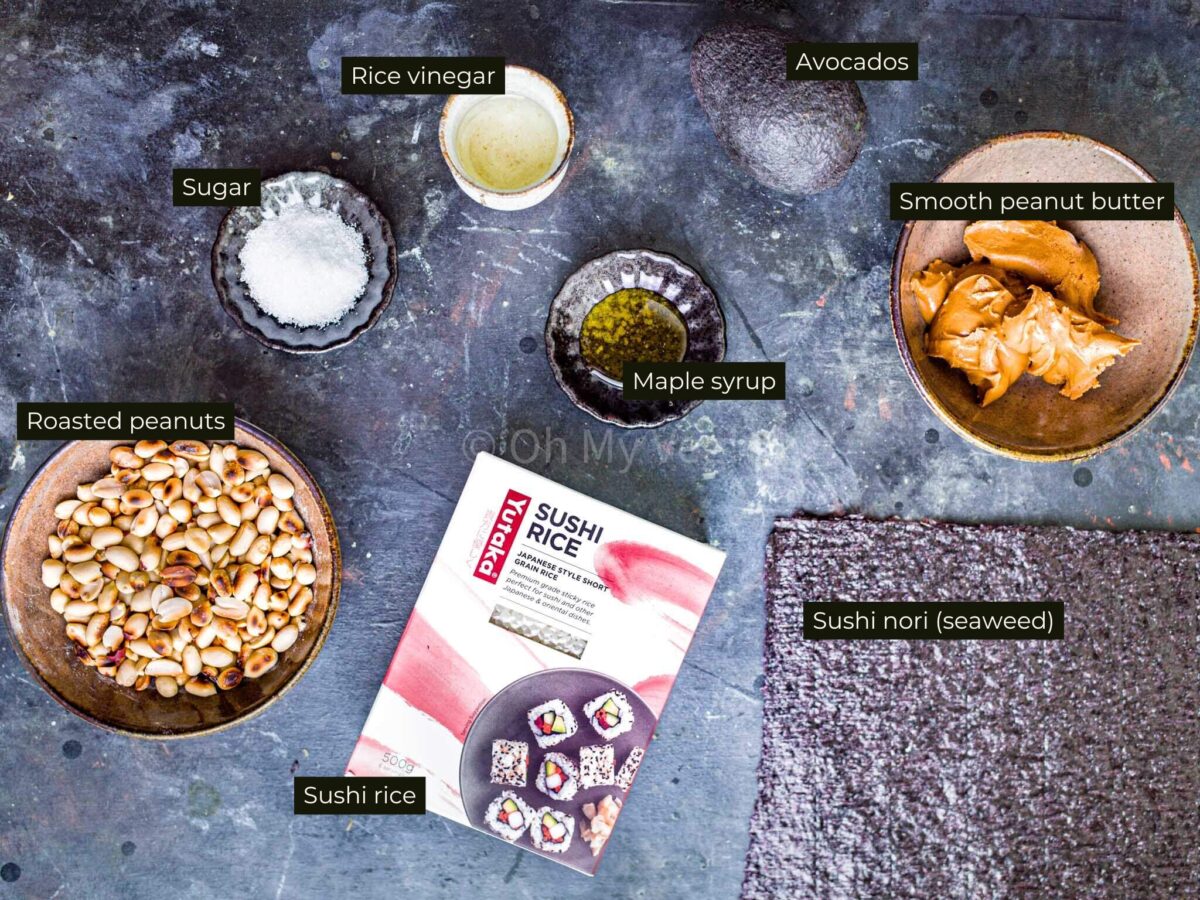
🍣 Ingredients for Peanut Avocado Rolls
Sushi is one of my favourite meals, not least because it requires very few ingredients! Head to your closest Asian market and you’ll find everything needed there.
I like to split the ingredients into two sections. Firstly, to cook the sushi rice, you’ll need:
- Sushi rice is crucial — don’t try to substitute for any other variety.
- Rice vinegar adds tang to the sushi rice.
- Sugar balances the sushi rice with a subtle sweetness.
- Salt is optional — the soy sauce usually used for dipping sushi is salty enough for me!
Secondly, you’ll need a few ingredients for the filling:
- Roasted peanuts add crunch. You can buy these or make your own, like I did.
- Peanut butter amps up the creamy factor and adds loads of plant-based protein.
- Maple syrup makes the filling pleasantly sweet (not overwhelmingly so). You can replace this with honey or golden syrup — both are sweeter, so adjust accordingly.
- Avocados are a classic sushi filling: deliciously buttery and mild.
- Sushi nori is packed with umami. In uramaki rolls (inside-out sushi), it forms a barrier between the fillings and sushi rice, helping to hold them in place.
🥑 Variations
These peanut avocado rolls are already 100% vegan, gluten free, dairy free, and soy free. But you can play around with the ingredients to make them suitable for different dietary requirements — or just for fun!
For example, why not sprinkle the sushi rice with black and white sesame seeds? It’s an easy addition, but adds a subtle nuttiness and makes the vegan sushi rolls look even more irresistible.
Additionally, why not add more fillings? The more the merrier, I say! Cucumber is a good addition — as is homemade tofu, for an extra boost in plant-based protein.
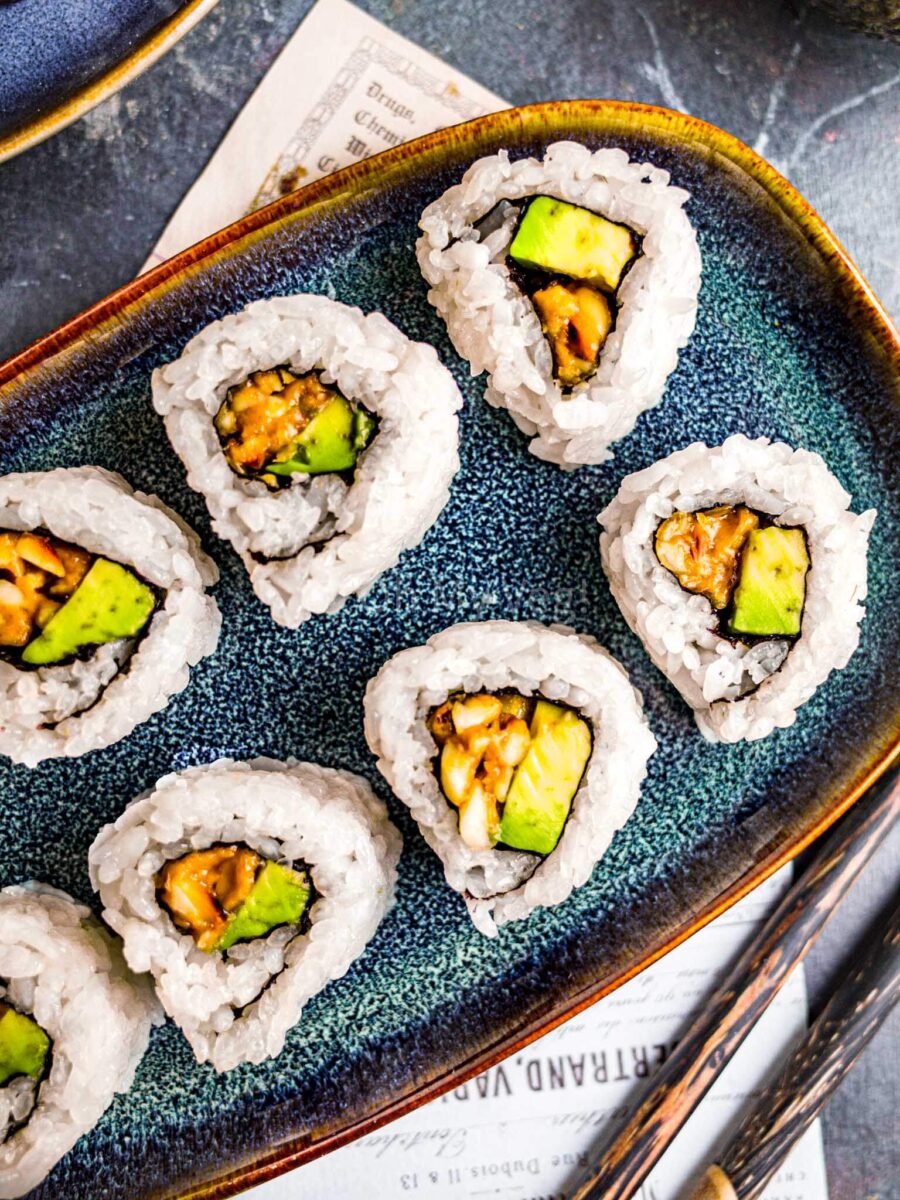
🧑🍳 How to Make Peanut Avocado Rolls
Making sushi may seem intimidating. After all, chefs train for years to become sushi masters — or “itamae.” But, don’t worry — it’s surprisingly easy to make restaurant-quality sushi at home.
- Wash the sushi rice thoroughly until the water runs clear.
- Let the rice sit in water (enough to cover) for 10 minutes, then drain.
- Add water, then place on the stove to cook, covered, until soft.
- While still hot, season the sushi rice with rice vinegar, sugar, and salt. Mix with a wooden spoon.
- Let the rice cool — keep it covered to prevent drying out.
- Roll out the uramaki by folding the instructions below.
How to Roll Uramaki Peanut Avocado Rolls (Step-by-Step Photos)
- Wrap your bamboo sushi mat (makisu) in cling film, to prevent the rice from sticking.
- Cut a sheet of sushi nori in half, then place it shiny side down on the mat.
- Spread a layer of sushi rice evenly on top of the sushi nori. Tip: Make sure your hands or sushi paddle are wet to press it down — this avoids sticking. (Fig 1)
- Carefully flip the sushi nori so the rice is on the clingfilm, and the sushi nori is pointing upwards.
- Arrange a thin line of the peanut mixture the whole length of the nori. (Fig 2)
- Then, place the cut avocado on top. (Fig 3)
- To roll, lift the bottom edge of the mat and roll the rice around the filling. Make sure it’s tight and even! (Fig 4)
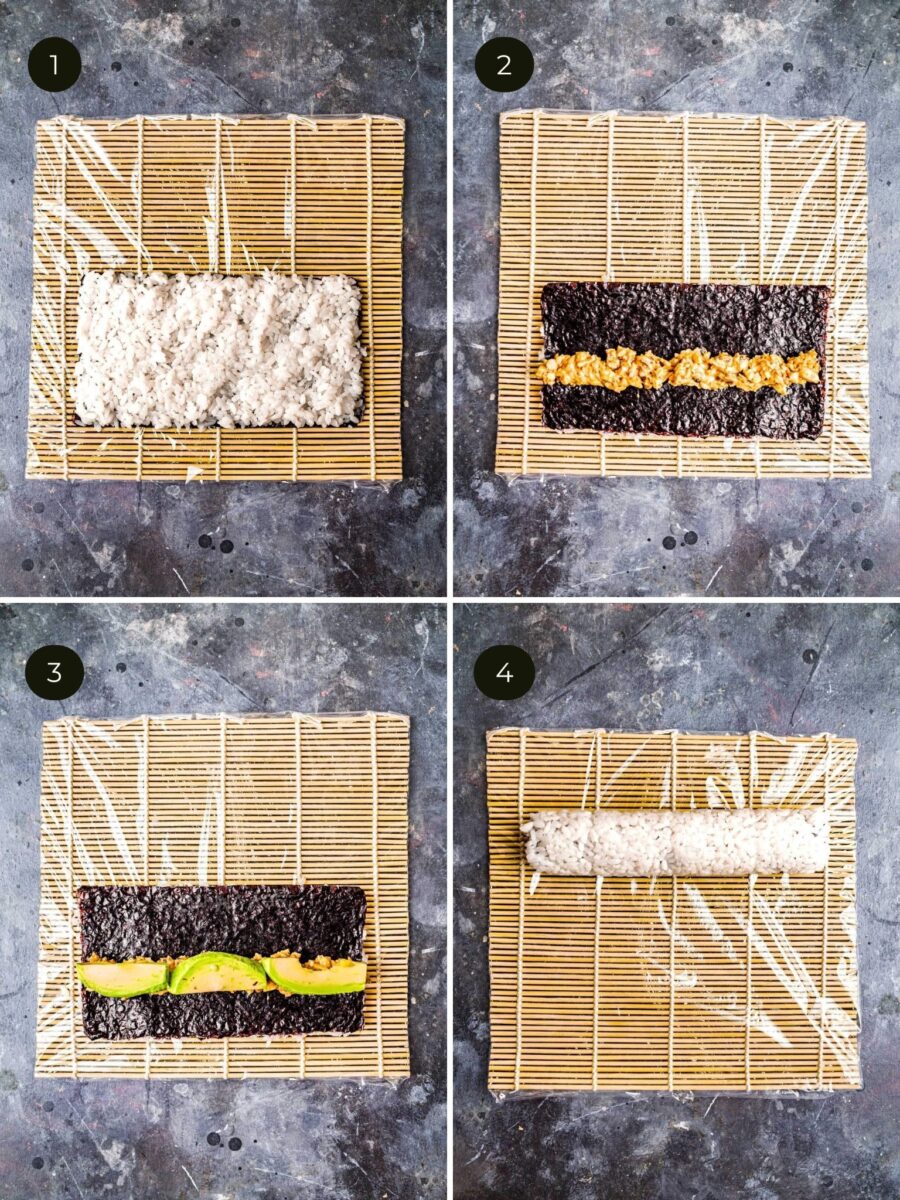
- To cut the sushi, wet your knife and cut the roll in half, applying even pressure and a gentle sawing motion. Wet the knife between each cut, and separate into 8 even pieces.
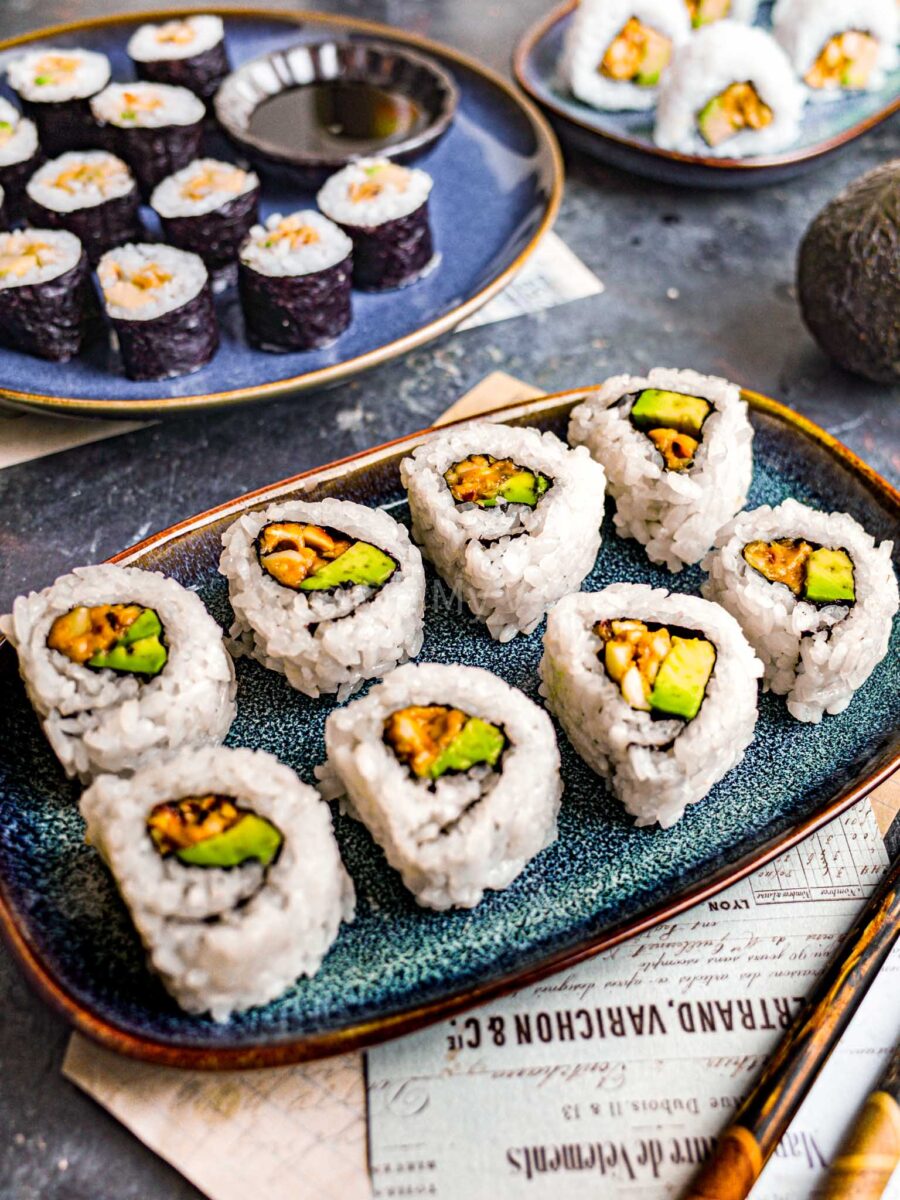
🍱 How to Serve Vegan Sushi Rolls
Traditionally, sushi is served with slivers of pickled ginger (gari), a touch of wasabi, and a soy sauce dip. However, to keep this recipe gluten free and soy free, you can substitute the soy sauce dip for coconut aminos.
Moreover, along with the classic accompaniments, you can serve the peanut avocado rolls as a starter to complement entrees like vegan tantanmen (tan tan ramen) or tofu katsu curry. You’ll have everything ready for a proper Japanese feast!
😍 Why You Should Make Peanut Avocado Rolls
If you tried this peanut avocado sushi roll recipe — or any other recipe on my website — please leave a 🌟 star rating and let me know your thoughts in the ✍️comments at the bottom of the page. Thanks for being a part of my community!
Peanut Avocado Roll
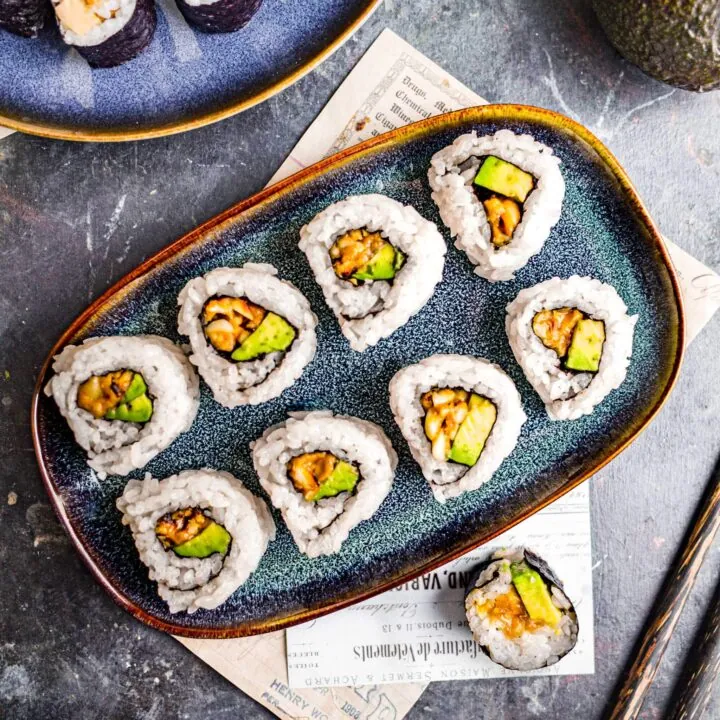
These vegan peanut avocado rolls feature sticky, buttery avocado and crunchy peanuts wrapped in perfectly cooked rice. It's unique and tasty!
Ingredients
For the Sushi Rice
- 200g Sushi Rice
- 180ml Water (to cook the rice)
- 2 tbsp Rice Vinegar
- 1 tbsp Sugar
- Pinch of salt, optional
For the Sushi Filling
- 2 Ripe Avocados, cut into small slices
- 60g Roasted Peanuts
- 2 tbsp Peanut Butter
- 2 tsp Maple Syrup
Instructions
To make the sushi rice:
- Thoroughly wash the rice until the water runs clear.
- Let the rice sit in enough water to cover for around 10 minutes, then drain. This is optional but makes the rice plumper.
- Add the sushi rice to a small saucepan along with 180ml water. Place on the stove at medium-low heat, covered. Cook for around 10-15 minutes, until all the water is absorbed and the rice is soft, yet sticky.
- While the rice is still hot, transfer it to a separate bowl. Season with rice vinegar, sugar, and a tiny pinch of salt. Mix with a wooden spoon. Don't use metal; it can react with the ingredients.
- Let the rice cool. Keep it covered (with a damp tea towel or lid) to prevent drying out.
To roll out the peanut avocado rolls:
- Wrap your bamboo sushi mat (makisu) in cling film, to prevent the rice from sticking.
- Cut a sheet of nori in half and place it shiny side down on the mat.
- Spread a layer of sushi rice evenly on top of the sushi nori. Wet your hands to prevent the rice from sticking, or use a wettened sushi paddle.
- Carefully flip the sushi nori so the rice is facing the clingfilm, while the sushi nori is facing upward.
- Arrange a thin line of the peanut mixture along the length of the nori.
- Top the peanut mixture with slices of avocado.
- Lift the bottom edge of the mat and carefully roll the rice around the filling. Press to ensure the roll is tight and even.
- Finally, cut the sushi into eight even-sized pieces using a sharp, wet knife. Keep the blade wet between cuts.
Repeat for all the remaining rolls!
Recommended Products
As an Amazon Associate and member of other affiliate programs, I earn from qualifying purchases.
Nutrition Information:
Yield:
4Serving Size:
1Amount Per Serving: Calories: 386Total Fat: 27gSaturated Fat: 4gTrans Fat: 0gUnsaturated Fat: 20gCholesterol: 0mgSodium: 225mgCarbohydrates: 33gFiber: 8gSugar: 9gProtein: 8g
Nutrition information isn’t always accurate.






